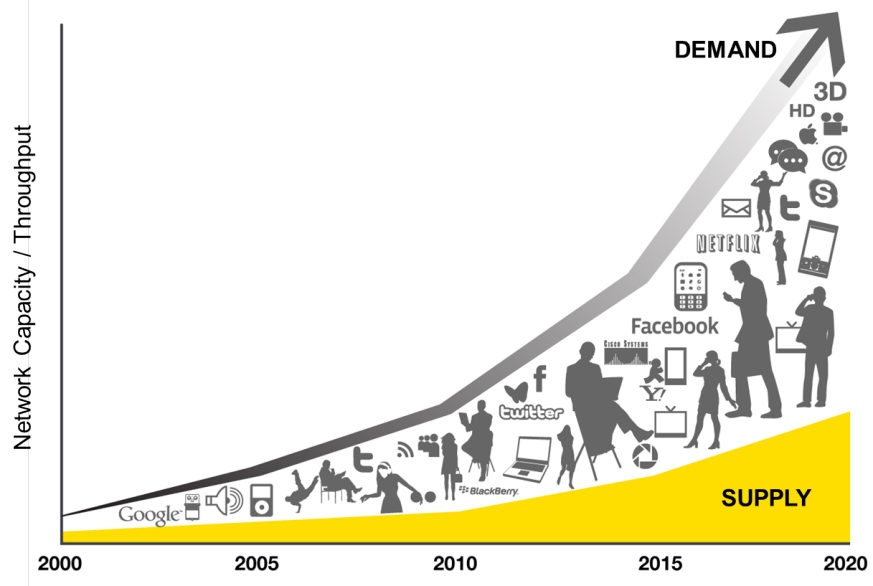April 29, 2014 – Guest blogger Jessica Oaks is the author of the following piece. This is her second contribution to 21st Century Tech blog. Jessica lives in Southern California. A journalism graduate of Cal State Long Beach, she loves to write about technology, finance, fashion, travel and more. In this posting she looks at the future of wireless both near and further out. Jessica is associate editor at www.freshlytechy.com, a blog that puts a sassy twist on technology. You can follow her on Twitter @TechyJessy. So please read, enjoy and comment on Jessica’s contribution to 21st Century Tech Blog.
———-
As quickly as technology is evolving, wireless services are in the background doing their best to keep up. Transformation is the name of the game. From a consumer point of view it’s a great time to own a smartphone or tablet. The adversarial contract model of the past is being phased out. You know the ones with ironclad commitments, expensive termination fees, no wiggle room and lots of restrictions.
Last year in the United States, carriers sprang up overnight with pricing plans that made people question why they were paying so much for data. Some big players in the sphere held fast, banking on the inconvenience for consumers to switch carriers. Others, like T-Mobile, fought back with no-contract plans – a first – and innovative programs like JUMP!, which untied upgrades from contracts. Further upsetting the status quo, T-Mobile even started offering free 4G LTE data for certain devices (Nexus 7 and iPad).
And wireless-equipped cars? They started happening with all kinds of manufacturers presenting features. And HD voice appears soon to follow. Coverage boosting “small cells” is already been deployed.
So the big question is “What’s really next?” Here are some predictions about what wireless will look like in the not-so-distant and the somewhat-more-distant future.
Wireless in 10+ Years
Many experts have predicted that the trend set by the self-described “uncarrier” T-Mobile will become the norm because no-contract plans are popular. But don’t expect the transformation to end there – especially where data is concerned. T-Mobile’s limited free 4G LTE could be the future of wireless. Or not.
Michael Mace, creator of Zekira, wrote way back when that the questions to which we’ll need answers before we can accurately describe the future of wireless include:
- How many users will pay for their own mobile data service?
- Will web companies also pay?
- Will the government step in?
- And most important, how much money will they be willing to pay?
Do we have the answers to these questions? Not yet.
And speaking of data, wireless networks may not expand fast enough to handle the volumes of traffic forecasted. Consequently the technology that delivers data may change to meet demand.
Expect to see the Internet of Things realized with device-to-device micro-networks competing effectively with wide-area. According to technology research firm Gartner, there will be about 26 billion devices on the Internet of Things by 2020. ABI Research predicts 30 billion devices. And the U.S. FCC is planning to auction off airwaves worth billions to wireless companies in the coming year.
Why is this so important? Google Executive Chairman Eric Schmidt recently said that, “by the end of the decade (2020), everyone on Earth will be connected to the Internet.” That’s perhaps 5 billion more people, many of whom may be connecting with networked solar-powered drones built by Titan Aerospace, now owned by (unsurprisingly) Google.
Wireless in 100 Years
Imagine a world where wireless service is ubiquitous and nearly free just like the information accessible through the Internet today. The Open Wireless Movement sees it happening thanks to a growing societal expectation of sharing.
Vint Cerf, hailed as one of the “Fathers of the Internet,” takes a more conservative view than Schmidt in a recent interview with The European, saying everyone on the planet will be networked by the early 2100s. And we will be moving mass quantities of data, if his further predictions pans out. “Huge amounts of knowledge will be available,” he states, “and we will have sufficient processing power to go with it. Augmented reality will be normal. Our homes, cars, offices and bodies will be thoroughly instrumented and monitored.”
While often presented in tongue-in-cheek style, the notion that we’ll move from a device-to-device micro network model to an implant-to-implant micro network model isn’t entirely outside of the realm of possibility.
For the wireless industry the biggest challenges remain unrelenting technological change, bridging the gap between the business models of today with whatever is coming next. It isn’t just the devices but also the infrastructure that is moving at light speed towards a universal paradigm, ubiquitous connectivity. For the industry it means a very disruptive future. For consumers it means lots of new and amazing uses of wireless.



















